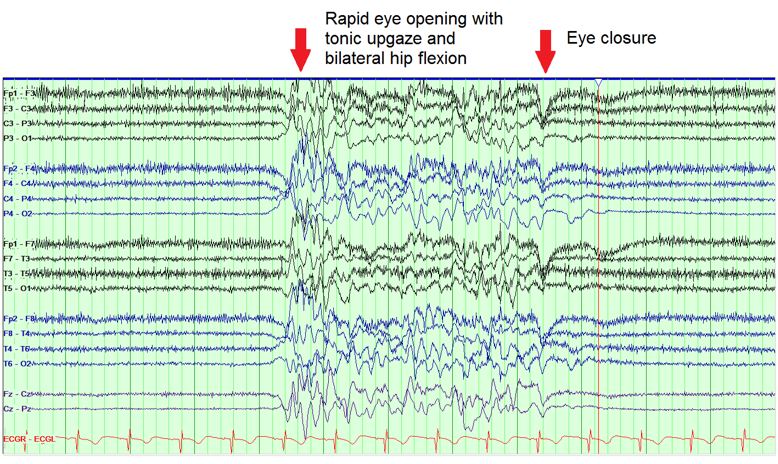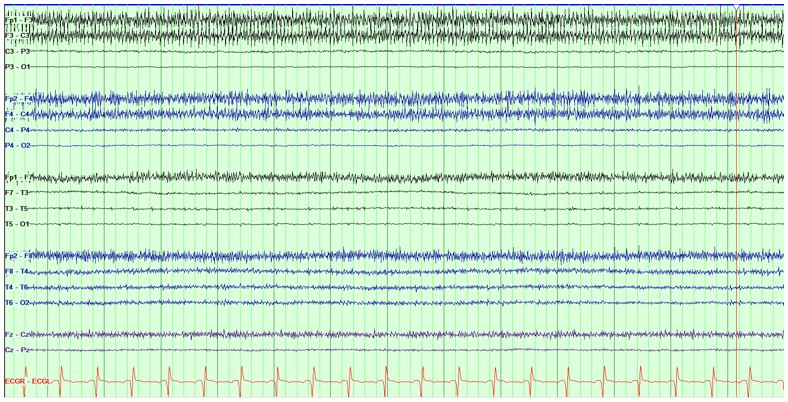March 2018
Featured Case
Submitted by Alexandra J. Sequeira, MD*; Derek Cheng, MD*; and Pegah Afra, MD
Case vignette:
A 55-year-old man with a past medical history of alcohol abuse was admitted status post cardiac arrest. He was reported to have asystole with return of spontaneous circulation (ROSC) achieved after 30 minutes. In the emergency room, he was found to have hypercapneic respiratory failure, intubated, started on hypothermia protocol, and was admitted to the intensive care unit. He was noted to have clinical eye twitching and rare leg movements, concerning for seizures, and was therefore placed on a propofol drip. He was subsequently started on continuous video electroencephalography (vEEG) monitoring. The vEEG revealed electrographic burst suppression pattern. Time locked to the bursts were stereotyped episodes of rapid eye opening, tonic upgaze and bilateral hip flexion with eye closure at conclusion of the burst (figure 1). Over the course of several days, the propofol drip was weaned off with eventual suppression of all cerebral activity (figure 2).
Figure 1:

Figure 2:

Question 1: Question 1: What are the possible types of clinical movements that can be seen during burst suppression in the setting of anoxic brain injury?
- Fragmentary myoclonic movements during bursts (focal, segmental or generalized myoclonus)
- Complex (non-myoclonic) movements during bursts (such as chewing, swallowing)
- Movements during periods of suppression (interburst intervals)
- All of the above
Answer: (click here)
A1: Correct answer: d.
A variety of movements have been reported during burst suppression EEG. These has included myoclonic movements and complex non-myoclonic movements during bursts as well as movements during interburst intervals.
Question 2: Which of the following is the most likely underlying mechanism for the clinical movements and EEG findings in this case?
- Ictal activity
- Motor programs at the brainstem or subcortical level
- Brainstem release phenomenon
- All of the above
Answer: (click here)
A2: Correct answer: a.
In this case most likely cause is ictal. This is due to the fact that the stereotyped movements are synchronous and time locked to the bursts suggesting presence of cortical activity with an excitatory influence on subcortical motor neurons (as in epileptic seizures). It also has been proposed that when myoclonic jerks occur during the bursts, the cortex may be severely damaged and not capable of generating activity. In case of isolated eye movement during bursts, progressive rostrocaudual deterioration in brain stem function has been proposed. We feel that there are cases for each of these suggested mechanisms in clinical practice. In our particular case, the movements likely represents electrographic seizures.
While myoclonic jerks occurring during the bursts can have both ictal and subcortical/brain stem etiology, presence of complex movements that are not myoclonic in nature suggest involvement of motor programs at the brain stem or subcortical levels. Movements that occur exclusively during interburst interval also suggest release of brain stem circuity.
Question 3: Does the fact that the patient has concomitant clinical movements during electrographic bursts change the poor prognosis?
- Yes
- No
Answer: (click here)
A3: Correct answer: b.
Burst suppression following cardiac arrest is associated with poor prognosis. The associated clinical movement (regardless of etiology being ictal or subcortical/brain stem etiology) should not change the poor prognosis of this condition. Other factors associated with poor prognosis includes status epilepticus, near-complete suppression and GPDs on a suppressed background.
References:
- Dericioglu N, Arsava EM, Topcuoglu MA. Periodic eye opening and upward eye deviation accompanied by burst-suppression, as an isolated clinical manifestation of acute post-hypoxic myoclonus. Epileptic disorders. 2015; 17 (1): 77-83
- Ferrara JM, Houghton DJ, Rao S. Periodic Eyelid opening associated with burst suppression electroencephalographyc due to hypoxic ischemic injury. NeuroCritical Care 2012. 17: 408-411.
- Reeves, AL; Westmoreland BF, Klass, DW. Clinical accompaniments of the burst-suppression EEG pattern. J Clin Neurophysiol 1997. 14 (2): 150-153.
- Hallet M. Physiology of human posthypoxic myoclonus. Mov Disord. 2000; 15 Suppl 1: 8-13.

